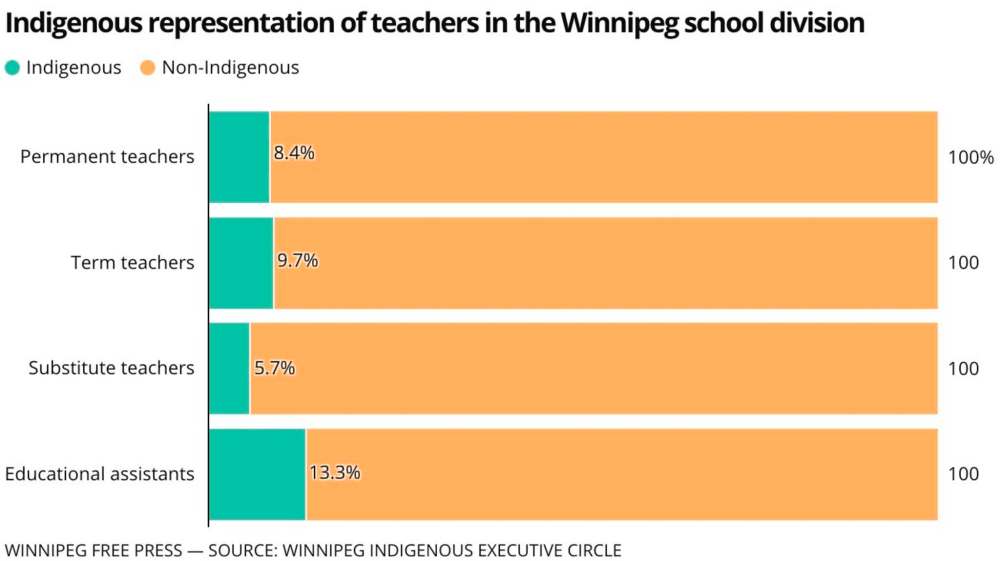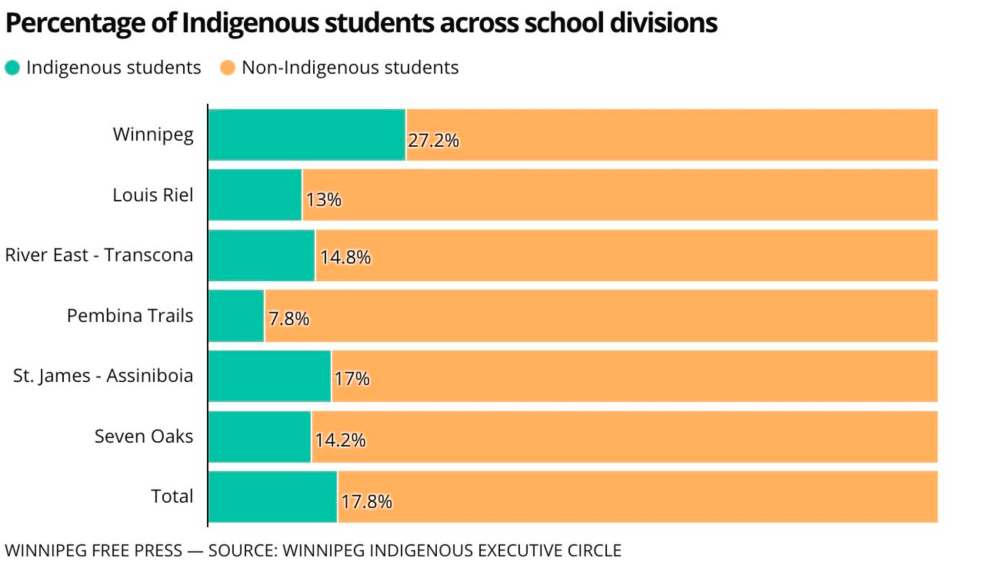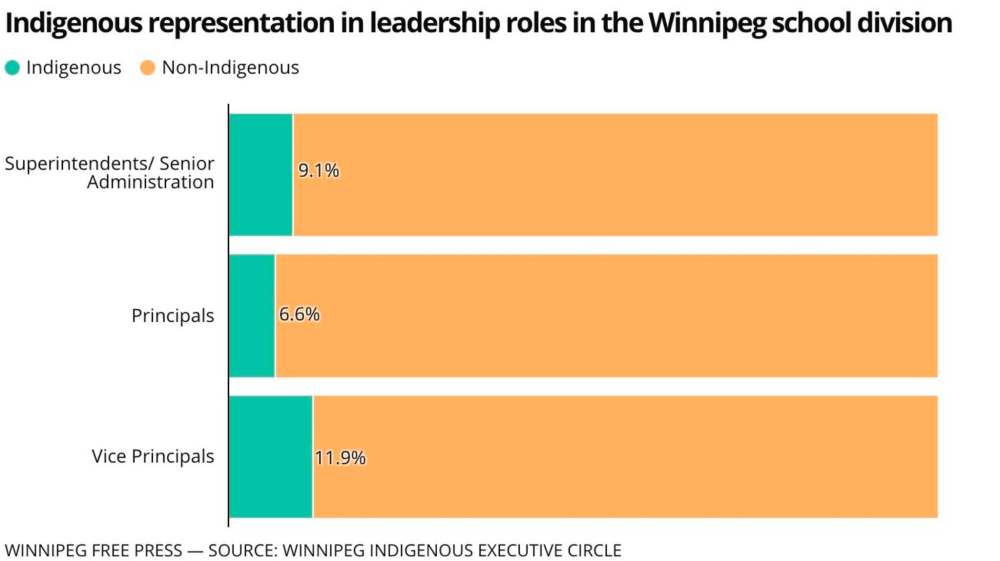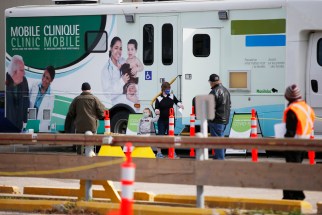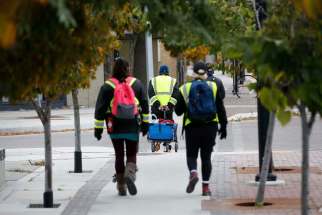Culture in the classroom Report aims to increase representation of Indigenous peoples as educators
Read this article for free:
or
Already have an account? Log in here »
To continue reading, please subscribe:
Monthly Digital Subscription
$0 for the first 4 weeks*
- Enjoy unlimited reading on winnipegfreepress.com
- Read the E-Edition, our digital replica newspaper
- Access News Break, our award-winning app
- Play interactive puzzles
*No charge for 4 weeks then price increases to the regular rate of $19.00 plus GST every four weeks. Offer available to new and qualified returning subscribers only. Cancel any time.
Monthly Digital Subscription
$4.75/week*
- Enjoy unlimited reading on winnipegfreepress.com
- Read the E-Edition, our digital replica newspaper
- Access News Break, our award-winning app
- Play interactive puzzles
*Billed as $19 plus GST every four weeks. Cancel any time.
To continue reading, please subscribe:
Add Free Press access to your Brandon Sun subscription for only an additional
$1 for the first 4 weeks*
*Your next subscription payment will increase by $1.00 and you will be charged $16.99 plus GST for four weeks. After four weeks, your payment will increase to $23.99 plus GST every four weeks.
Read unlimited articles for free today:
or
Already have an account? Log in here »
Hey there, time traveller!
This article was published 05/10/2020 (1892 days ago), so information in it may no longer be current.
In the third grade Malaihka Siemens met the first — and only — classroom teacher she would ever have who looked like her.
At the time, Frances Smith was approximately five-foot-four with short black hair, glasses and a teaching style that incorporated sharing circles into the classroom, recalls Siemens, now in her final year in Manitoba’s public school system.
“Up until then, I hadn’t seen anybody Indigenous in a teacher’s position,” says the 17-year-old, who is Oji-Cree and Kenyan.
“From there, I had this vision of me being in her position and I kind of vicariously lived through her in her classroom because I was so fascinated with the way she incorporated our culture into her lessons so eloquently.”
Had Siemens not been in Smith’s class at Sister MacNamara School, she may never have put becoming a teacher on her bucket list.
That’s the premise behind a new report card on the state of equity in Manitoba’s K-12 education system.
Authored by the Winnipeg Indigenous Executive Circle, the report outlines the underrepresentation of Indigenous peoples as teachers in classrooms of all grade levels, in post-secondary faculties of education and on public school boards across the province.
“In order to improve academic outcomes for Indigenous students, they need to see themselves better reflected in the curriculum and teaching staff working in their schools,” states the 31-page-document, which is to be made public Tuesday.
While the authors acknowledge the traumas of the residential school system and related issues of poverty and mental health care must be taken into account when working to improve Indigenous graduation rates, they argue representation plays an important role in boosting outcomes.
“A teacher is really important to the lives of the kids, as we all know, and having more Indigenous educators in those positions and giving (students) different viewpoints, the class as a whole, I think is a great goal,” said Trevor LaForte, co-chairman of the Winnipeg Indigenous Executive Circle.
LaForte added that achieving such a goal requires both data collection and targets to improve the status quo at training and division levels — which are among the 10 calls to action listed in the report.
Other calls to action range from an ask all divisions create an employment equity policy to a call for universities to release annual Indigenous enrolment and graduation reports to the creation of a designated Indigenous seat on school boards.
The report draws on survey response data collected from the six Winnipeg-area school divisions and the faculties of education at the University of Manitoba, University of Winnipeg, University of Saint-Boniface and Brandon University in the spring of 2019.
The data indicate that in 2017-18, Indigenous students accounted for 27.2 per cent of the student population in the Winnipeg School Division. That same year, according to the report, 8.4 per cent of the division’s permanent teaching staff identified as Indigenous, while Indigenous support staff made up 13.3 per cent of its educational assistant roster.
The River East Transcona, Louis Riel, Pembina Trails, St. James-Assiniboia and Seven Oaks divisions did not provide detailed Indigenous self-identification figures — more often than not, citing the fact they do not collect such data.
As for a breakdown of teachers-in-training, figures in the report show Indigenous students accounted for 6.6 per cent of the total Bachelor of Education graduates at the U of W, on average, between 2011 and 2015. During that same period, the mean annual percentage at the U of M was 5.2 per cent.
Also in the report is a breakdown of the number of Indigenous trustees — 2 of 54 across the city’s six divisions — serving on school boards in Winnipeg. Both Métis trustees currently serve on the province’s largest board in central Winnipeg.
A co-author of the equity report and former trustee, Sonia Prevost-Derbecker knows firsthand the importance of having Indigenous representation on school boards, as well as how exhausting it can be to be the only Indigenous voice at a decision-making table.
“If you have Indigenous people at the table, you’ll have a greater chance of ensuring that Indigenous issues get a place of priority and outcomes will change as a result,” she said.
Prevost-Derbecker is an advocate for empowering Indigenous students to become teachers. She wants to see Manitoba create an Indigenous education program at the post-secondary level, which is another one of the collective’s calls to action.
In the Winnipeg School Division, the Build From Within Program — a program in partnership with U of W and Indspire Canada — aims to mentor and train Indigenous high school students to help them develop a path to become teachers.
Siemens is currently on that path. The Grade 12 student currently at Argyle Alternative High School said she often thinks back to how she felt in Smith’s classroom in Grade 3. Between Smith and the elders in her life, she said she has had a number of educational role models that have influenced her confidence as a learner.
She plans to graduate in June and study to become either a teacher or professor in the future.
“I hope to represent all the people who haven’t felt that they have been represented and seen and heard and valued in education and in their learning experiences,” Siemens added.
maggie.macintosh@freepress.mb.ca
Twitter: @macintoshmaggie
10 Calls to Action
A call for designated seats on school boards for Indigenous peoples proportionate to the population of Indigenous students being served.
A call on school divisions to create targets for Indigenous teacher hires and monitor their results via the development of an employment equity policy and program.
A call on divisions to consider modelling an employment equity policy and program after the Employment Equity Toolkit for Recruiting and Retaining Educators of Aboriginal Ancestry in British Columbia.
A call on divisions to release annual employment equity reports that are readily accessible to the public.
A call on divisions to review existing human resource policies and practices to identify barriers and promising practices regarding the recruitment, hiring, retention and promotion of Indigenous teachers.
A call on divisions to develop modernized employment equity policies that are based on the setting of targets proportionate to the student population of the division so the number of Indigenous teachers better reflects the Indigenous student population.
A call on post-secondary education faculties to set equity enrolment targets for Indigenous students similar to the Diversity Admissions Policy established by the University of Manitoba’s faculty of education, and release annual equity enrolment and graduation reports.
A call on the U of M, University of Winnipeg, Brandon University and the University of Saint-Boniface to breakdown employment equity data for the respective schools and publish annual reports that include: targets for Indigenous staff; self-identification form completion rates; identification of employed faculty and staff by job category; retention rates of Indigenous staff; and promotion data of Indigenous employees.
A call on Manitoba Education to publish self-identification student and teacher data for Indigenous peoples broken down by individual school divisions, on a three-year basis.
A call on all education stakeholders — including, the Manitoba School Boards Association, Manitoba Association of School Superintendents, Manitoba Teachers’ Society and deans of the faculties of education — to partner with Indigenous organizations to create a More Indigenous Teachers initiative to identify barriers faced by Indigenous people to become teachers, develop recruitment strategies and create a Bachelor of Education – Indigenous Knowledges program governed by Indigenous peoples, among other things.
— Winnipeg Indigenous Executive Circle

Maggie Macintosh reports on education for the Winnipeg Free Press. Funding for the Free Press education reporter comes from the Government of Canada through the Local Journalism Initiative.
Our newsroom depends on a growing audience of readers to power our journalism. If you are not a paid reader, please consider becoming a subscriber.
Our newsroom depends on its audience of readers to power our journalism. Thank you for your support.
History
Updated on Monday, October 5, 2020 7:54 PM CDT: Adds photos.
Updated on Monday, October 5, 2020 11:16 PM CDT: Fixes typo in photo caption.
Updated on Tuesday, October 6, 2020 10:12 AM CDT: Corrects name of Build From Within program; clarifies Prevost-Derbecker's role

